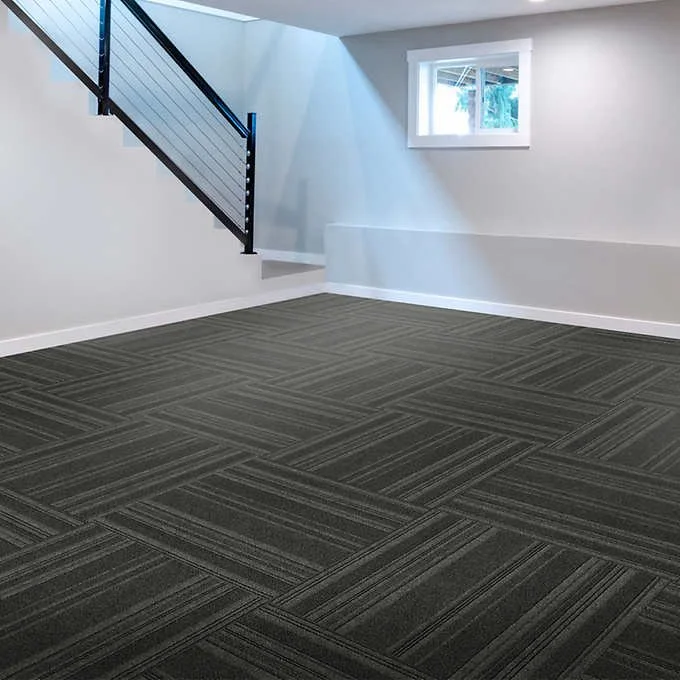Why Carpet Tile?
The invention of carpet tile was one that would change the industry forever. Installed using pressure sensitive adhesive or tactless, this floor can be easily removed and repaired when spills occur. These carpets come in wide array of colors, styles, and shapes. Some of the shapes include planks, squares, octogens and more.
For commercial applications, there are numerous advantages to carpet tile, as outlined below.
-
Thanks to their smaller size, carpet tiles are easier to lift, move and install compared to broadloom carpets. Their modularity also typically produces less waste during installation, as you are able to select tiles in various sizes to better fit specific spaces.
These two factors combined can offer noticeable cost savings, as well as help the project run smoothly.s here
-
Broadloom and modular carpet have similar cleaning requirements: regular vacuuming with the occasional deep clean.
But once you move past everyday maintenance, the differences between these two flooring types becomes apparent. It is easier to spot-replace carpet tiles rather than sections of broadloom, both practically, and in terms of ensuring design continuity.
Damaged tiles can be removed and then replaced with new tiles from your attic stock, whereas damaged sections of the broadloom need to be cut out, removed, and then replaced with a new broadloom, which will look markedly different from the existing carpet, creating a ‘patchwork’ effect that is often more noticeable than the initial damage.
-
There are several factors that affect carpet durability, and not all types of carpet offer the same performance and longevity. However, it’s easy to select carpet tiles that are durable when keeping a few key factors in mind.
The most important element is the backing on carpet tiles: Some carpet tiles have cushion backing, which helps absorb the impact of foot traffic and protects carpet fibers from the wear and tear that speeds up appearance degradation.
Hard-backed carpet tiles will be less durable than cushion-backed modular carpet and broadloom. Despite its plush feel, it won’t wear as well as a modular carpet due to the difficulty in spot-replacing stained or damaged portions.
-
Carpet tiles offer greater design flexibility than broadloom carpet and even many types of hard flooring.
Different carpet dye technologies make it possible to create a wide range of colors, patterns, and designs on modular carpets that you can’t recreate in broadloom. For example, Milliken’s proprietary print technology applies dye to the carpet after it’s cut into tiles, meaning you achieve perfect design registration across all four edges of the tile, so designs flow almost seamlessly from tile to tile.
When installing modular carpets, you have even greater design freedom: you can install them in different configurations to create subtle patterning; add accent tiles for a splash of color, or create patterns with complementary tiles.
-
Modular carpet offers significant ambient improvements – especially compared with hard surface flooring. The layered structure of modular carpet means it absorbs more structure-borne sound than hard flooring -and even broadloom – which can amount to a noticeable improvement in noise levels, particularly in large, open-plan commercial spaces.
Carpet tiles with cushion backing also offer health and wellness benefits: they can reduce muscle fatigue when standing by 24%, improving underfoot comfort. It also helps reduce the frequency and severity of slips and falls compared with hard flooring.
Benefits Of Carpet Tile
Ready To Start?
We will gladly educate and help guide our customers through the tile selection process. Choosing the texture, colors, finish, and style of tile can be overwhelming to some. However, rest assured as our skilled staff are here to help every step of the way. We will happily guide you through the process of selecting the right tile for your project, as well as provide the most competitive pricing in the area for both product and installation. Our installers have all of the necessary tools, equipment, and training to ensure your floor is installed properly the first time.
We are confident that you’ll be satisfied with our installation rates as well as the finished product. It’s how we’ve become Southwest Florida’s premier flooring company!
We are looking forward to assisting you in your next project
Contact our office today to review your next flooring project at (863) 517-9076, or through the form below. We welcome the opportunity to exceed your expectations!

